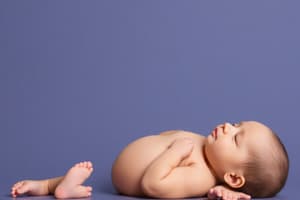Podcast
Questions and Answers
What key developmental milestone is associated with the onset of stranger anxiety?
What key developmental milestone is associated with the onset of stranger anxiety?
- 6 months of age
- 3 months of age
- 10 months of age
- 8 months of age (correct)
At what age does an infant typically begin to roll from supine to prone and back?
At what age does an infant typically begin to roll from supine to prone and back?
- 6 months
- 5 months (correct)
- 4 months
- 7 months
Which of the following actions signifies the coordination of secondary schemes in infants?
Which of the following actions signifies the coordination of secondary schemes in infants?
- Sucking reflex only
- Using hand-eye coordination to reach for a toy (correct)
- Rolling over
- Crawling on hands and knees
What is a characteristic of an infant's temperament that ranges between low and moderate activity levels?
What is a characteristic of an infant's temperament that ranges between low and moderate activity levels?
Which fine motor skill is expected to develop first in infants?
Which fine motor skill is expected to develop first in infants?
What is the term used to describe the distress an infant experiences when a parent leaves?
What is the term used to describe the distress an infant experiences when a parent leaves?
What fine motor skill is typically acquired by an infant at 10 months of age?
What fine motor skill is typically acquired by an infant at 10 months of age?
Which substage of Piaget's sensorimotor theory includes the use of reflexes?
Which substage of Piaget's sensorimotor theory includes the use of reflexes?
What is the average weight of an infant at birth?
What is the average weight of an infant at birth?
At what age does an infant's head circumference typically increase by about 10 cm?
At what age does an infant's head circumference typically increase by about 10 cm?
Which primitive reflex disappears last during the first year of life?
Which primitive reflex disappears last during the first year of life?
What is a significant change in the cardiovascular system of an infant during the first year?
What is a significant change in the cardiovascular system of an infant during the first year?
What type of stool does an infant produce immediately after birth?
What type of stool does an infant produce immediately after birth?
What best describes the change in the respiratory system of an infant compared to an adult?
What best describes the change in the respiratory system of an infant compared to an adult?
At what age do the first primary teeth typically begin to erupt?
At what age do the first primary teeth typically begin to erupt?
Which reflex involves the infant turning their head when the mouth is stroked?
Which reflex involves the infant turning their head when the mouth is stroked?
What is a key characteristic of the genitourinary system in infants?
What is a key characteristic of the genitourinary system in infants?
Which developmental theory relates to the conflict of trust versus mistrust in infants?
Which developmental theory relates to the conflict of trust versus mistrust in infants?
What characteristic of an infant's respiratory system makes them more susceptible to respiratory issues compared to adults?
What characteristic of an infant's respiratory system makes them more susceptible to respiratory issues compared to adults?
At what age does the Moro reflex typically disappear in infants?
At what age does the Moro reflex typically disappear in infants?
Which of the following systems remains immature at birth and gradually matures over the first year of life?
Which of the following systems remains immature at birth and gradually matures over the first year of life?
How does the average pulse rate of an infant change from birth to 1 year of age?
How does the average pulse rate of an infant change from birth to 1 year of age?
What change typically occurs in an infant's hematopoietic system during the first few months after birth?
What change typically occurs in an infant's hematopoietic system during the first few months after birth?
What is the main function of the protective reflexes that develop as primitive reflexes disappear?
What is the main function of the protective reflexes that develop as primitive reflexes disappear?
What is the average weight of an infant at 12 months of age compared to their weight at birth?
What is the average weight of an infant at 12 months of age compared to their weight at birth?
What physiological change occurs in an infant's skin compared to that of an adult?
What physiological change occurs in an infant's skin compared to that of an adult?
What is a key factor influencing the development of an infant's gastrointestinal system?
What is a key factor influencing the development of an infant's gastrointestinal system?
Which of the following reflexes typically disappears first during the first year of life?
Which of the following reflexes typically disappears first during the first year of life?
What developmental milestone is typically achieved when infants start to pull to stand?
What developmental milestone is typically achieved when infants start to pull to stand?
During which substage of Piaget's sensorimotor theory do infants begin to perform secondary circular reactions?
During which substage of Piaget's sensorimotor theory do infants begin to perform secondary circular reactions?
At which age do infants typically begin to sit unsupported?
At which age do infants typically begin to sit unsupported?
What is a common characteristic of the fine motor skills of an 11-month-old infant?
What is a common characteristic of the fine motor skills of an 11-month-old infant?
What defines the temperament of infants with highly active traits?
What defines the temperament of infants with highly active traits?
When do infants generally develop separation anxiety?
When do infants generally develop separation anxiety?
What significant change occurs in the gross motor skills of infants by 12 months of age?
What significant change occurs in the gross motor skills of infants by 12 months of age?
What action signifies the primary circular reactions in infants?
What action signifies the primary circular reactions in infants?
Flashcards
Infant weight gain
Infant weight gain
Average infant weight is 3,400g (7.5lb) at birth, doubling by 4-6 months and tripling by 12 months.
Infant length growth
Infant length growth
Average infant length is 50cm (20in) at birth and increases by 50% by 12 months.
Head circumference
Head circumference
Infant head circumference is 35cm (13.5in) at birth, increasing about 10cm by 12 months.
Assessing developmental milestones
Assessing developmental milestones
Signup and view all the flashcards
Primitive reflexes
Primitive reflexes
Signup and view all the flashcards
Step reflex
Step reflex
Signup and view all the flashcards
Sucking reflex
Sucking reflex
Signup and view all the flashcards
Moro reflex
Moro reflex
Signup and view all the flashcards
Respiratory System Immaturity
Respiratory System Immaturity
Signup and view all the flashcards
CV System Changes
CV System Changes
Signup and view all the flashcards
Infant Development (0-12 months)
Infant Development (0-12 months)
Signup and view all the flashcards
Stranger Anxiety
Stranger Anxiety
Signup and view all the flashcards
Separation Anxiety (Infants)
Separation Anxiety (Infants)
Signup and view all the flashcards
Gross Motor Skills (0-12 Months)
Gross Motor Skills (0-12 Months)
Signup and view all the flashcards
Fine Motor Skills (0-12 Months)
Fine Motor Skills (0-12 Months)
Signup and view all the flashcards
Sensorimotor Stage (Piaget)
Sensorimotor Stage (Piaget)
Signup and view all the flashcards
Oral Stage (Freud)
Oral Stage (Freud)
Signup and view all the flashcards
Infant Temperament
Infant Temperament
Signup and view all the flashcards
Primary Circular Reactions
Primary Circular Reactions
Signup and view all the flashcards
Secondary Circular Reactions
Secondary Circular Reactions
Signup and view all the flashcards
Coordination of Secondary Schemes
Coordination of Secondary Schemes
Signup and view all the flashcards
Separation Anxiety
Separation Anxiety
Signup and view all the flashcards
Temperament (Infants)
Temperament (Infants)
Signup and view all the flashcards
Tripod Sit
Tripod Sit
Signup and view all the flashcards
Gross Motor Skills
Gross Motor Skills
Signup and view all the flashcards
What is the average weight of an infant at birth?
What is the average weight of an infant at birth?
Signup and view all the flashcards
How much does an infant's weight increase by 12 months?
How much does an infant's weight increase by 12 months?
Signup and view all the flashcards
What is the average length of an infant at birth?
What is the average length of an infant at birth?
Signup and view all the flashcards
How does infant length change in the first year?
How does infant length change in the first year?
Signup and view all the flashcards
What is the average head circumference of an infant at birth?
What is the average head circumference of an infant at birth?
Signup and view all the flashcards
How much does an infant's head circumference increase by 12 months?
How much does an infant's head circumference increase by 12 months?
Signup and view all the flashcards
Why are primitive reflexes present at birth?
Why are primitive reflexes present at birth?
Signup and view all the flashcards
What happens to primitive reflexes as the infant develops?
What happens to primitive reflexes as the infant develops?
Signup and view all the flashcards
What is the function of protective reflexes?
What is the function of protective reflexes?
Signup and view all the flashcards
How does the respiratory system change as the infant develops?
How does the respiratory system change as the infant develops?
Signup and view all the flashcards
Study Notes
Infant Growth
- Weight: Average infant weighs 3,400g (7.5 lb) at birth. Weight doubles by 4-6 months and triples by 12 months.
- Length: Average length is 50 cm (20 in) at birth, increasing by 50% by 12 months.
- Head Circumference: Average head circumference is 35 cm (13.5 in) at birth, increasing by approximately 10 cm by 12 months.
Assessing Developmental Milestones
- Parent Evaluation: Inquire with the parent about developmental milestones attained.
- Observation: Observe the skill during assessment.
- Screening Tools: Employ screening tools such as:
- Ages and Stages Questionnaire (ASQ)
- Infant-Toddler Checklist (ITC)
- Infant Development Inventory (IDI)
- Parents' Evaluation of Developmental Status-Developmental Milestones (PEDS-DM).
Physiologic Changes
- Immature Systems: Infant systems are immature at birth, maturing over the first year.
- Neurologic System: The central nervous system (CNS) isn't fully myelinated. Primitive reflexes are present at birth.
Reflexes
- Step: The infant kicks legs when held upright (disappears 4-8 wk).
- Root: Turns head towards a touched or stroked area on the mouth (disappears 3 mos).
- Suck: Disappears (2-5 mos).
- Moro: Startle reflex (disappears 4 mos).
- Asymmetric Tonic Neck: Opposite arm and leg extension (disappears 4 mos).
- Plantar: Toes curl backward when sole of foot is stimulated (disappears 9 mos).
- Palmar Grasp: Grasps fingers introduced to the palm (disappears 4-6 mos).
- Babinski: Toes fan out when sole of foot is stimulated (disappears 12 mos).
- Neck Righting: Turns head when lying on the back (4-6 mos).
- Parachute (Sideways): Reaches out opposite the push to prevent falling sideways (6 mos).
- Parachute (Forward): Reacts to forward rotation while held upright (6-7 mos).
- Protective Reflexes: As primitive reflexes fade, protective reflexes develop for maintaining balance and are present throughout life.
Respiratory System
- Immature Structures: Infant nasal passages are narrower, the larynx is more funnel-shaped, and the trachea and chest wall are more compliant than in adults.
- Less Developed Alveoli: Bronchi, bronchioles and alveoli are also less developed, Fewer in number.
- High Respiratory Rate: Respiratory rate is initially high but decreases with maturity.
Cardiovascular System
- Heart Growth: Heart doubles in size during the first year.
- Pulse Rate: Average pulse rate is 120-140 bpm in newborns, decreasing to approximately 100 bpm by one year.
- Blood Pressure: Average blood pressure is 60/40 in newborns, consistently increasing to 100/50 by 12 months.
- Peripheral Capillaries: Peripheral capillaries are closer to the skin surface, making newborns and young infants more susceptible to heat loss, with improved thermoregulation over the first few months.
Gastrointestinal System
- Tongue Size: Infant tongue is large relative to oral cavity size, aiding in latching.
- Increased Stomach Capacity: Stomach capacity increases with growth.
- Teeth Emergence: First primary teeth (incisors) typically erupt between 6 - 8 months.
- Stool Changes: Stools change from meconium at birth to varying consistencies and frequencies based on feeding.
Genitourinary System
- Frequent Urination: Frequent urination is common.
- Low Specific Gravity: Specific gravity of the urine is lower.
- Reduced Renal Function: All renal functions are less developed compared to adults.
- Dehydration Susceptibility: Infants are more susceptible to dehydration.
- Poor Urine Concentration: Their ability to concentrate urine is less efficient.
Integumentary System
- Newborn Characteristics: Lanugo and vernix may be present at birth. Acrocyanosis is normal in newborns (and fades within days).
- Thin Skin: Infant skin is relatively thinner than adult skin.
- Superficial Capillaries: Peripheral capillaries are more superficial, leading to greater heat loss susceptibility.
Hematopoietic and Immunologic Systems
- High Hemoglobin: High hemoglobin level at birth, decreasing over the first 2-3 months, stabilizing by 6-9 months with adequate iron intake.
- Maternal IgG: Maternal IgG is transmitted to the infant, protecting it in the first 3-6 months of life.
Developmental Theories
- Erikson: Trust vs. Mistrust (birth-1 year). Responding to needs (feeding, diaper changing etc). Infant realizes separateness from parents.
- Piaget: Sensorimotor (birth to 2 years):
- Stages 1-4: Reflexive behavior, circular reactions, object permanence to more complex interactions. Learning from senses and motor skills.
- Freud: Oral Stage (birth to 1 year): Focus on feeding and sucking.
Social and Emotional Development
- Stranger Anxiety: Develops around 8 months, infant recognizing self as separate.
- Separation Anxiety: Develops later, infant distressed upon parent's leaving.
- Temperament: Ranges from low - moderately active, regular and predictable to highly active, intense, less adaptable.
Gross Motor Skill Progression
- 1 Month: Lifts, turns head when prone, head lag.
- 2 Months: Raises head and chest, improving head control.
- 3 Months: Raises head 45 degrees in prone, slight head lag.
- 4 Months: Lifts head and looks around, rolls from prone to supine.
- 5 Months: Rolls from supine to prone and back, sits upright with support.
- 6 Months: Tripod sits.
- 7 Months: Sits alone with some use of hands.
- 8 Months: Sits unsupported.
- 9 Months: Crawls, abdomen off floor.
- 10 Months: Pulls to stand, cruises.
- 12 Months: Sits from standing position, walks independently.
Fine Motor Skill Progression
- 1 Month: Fists mostly clenched, involuntary hand movements.
- 3 Months: Holds hand in front of face, hands open.
- 4 Months: Bats at objects.
- 5 Months: Grasps rattle.
- 6 Months: Releases object to take another.
- 7 Months: Transfers objects from one hand to the other.
- 8 Months: Gross pincer grasp (rakes).
- 9 Months: Bangs objects together.
- 10 Months: Fine pincer grasp, places and removes objects.
- 11 Months: Offers and releases objects to others.
- 12 Months: Feeds self, makes marks, pokes with index finger.
Premature Infants
- Detail omitted. (Information about premature infants was not fully described in the text.)
Studying That Suits You
Use AI to generate personalized quizzes and flashcards to suit your learning preferences.




